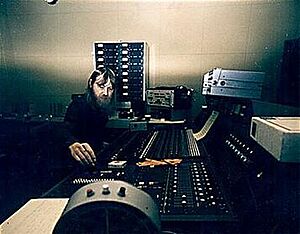Conny Plank facts for kids
Quick facts for kids
Conny Plank
|
|
|---|---|

Plank at the Windrose studio in Hamburg
|
|
| Background information | |
| Birth name | Konrad Plank |
| Born | 3 May 1940 Hütschenhausen, Germany |
| Died | 5 December 1987 (aged 47) Cologne, West Germany |
| Genres |
|
| Occupation(s) | Record producer, musician |
| Instruments |
|
| Years active | 1969–1987 |
| Labels |
|
| Associated acts |
|
Konrad "Conny" Plank (born May 3, 1940 – died December 5, 1987) was a German record producer and musician. He was famous for his new and creative ways of working with sound. He helped shape the "krautrock" and "kosmische musik" scenes in Germany during the 1970s.
Plank worked with many well-known German bands. These included Neu!, Kraftwerk, Cluster, and Harmonia. Later, he produced music for popular "new wave" bands. Some of these were Eurythmics and Ultravox. Conny Plank also played music himself. He was part of the group Moebius & Plank and released five albums with them.
Contents
Conny Plank's Music Style
Conny Plank and the bands he worked with had a big impact on music. Many mainstream rock artists were influenced by his unique production style. In the 1980s, electronic pop bands used his ideas. This was easier as computerized instruments became available.
Plank started his career working with singer Marlene Dietrich. He strongly believed in the power of electronic music. He loved creating electronic "soundscapes," which are like musical pictures made of sound. He also mixed these electronic sounds with normal ones. Sometimes he used everyday objects, like large metal containers, as musical instruments.
Plank used "multi-track recording" to make his music. This allowed him to record many different sounds at once. He liked to use strong effects like echo and reverb. He made each sound in a song stand out. He combined electronic effects, mixing, and editing to create his unique sound.
Plank also liked a "live" sound, especially for drums. He would set up microphones in special ways. This helped him get unusual drum sounds in his recordings.
Conny Plank's Career
The 1960s
Conny Plank began producing albums and working as a sound engineer in the late 1960s. He became part of the exciting underground music scene in Germany. In 1969, he was the engineer for the first Kluster album, Klopfzeichen. He worked closely with Dieter Moebius and Hans-Joachim Roedelius from Kluster for many years. They later formed the band Cluster. Plank also engineered other albums, starting his long list of production work.
The 1970s
In 1970, Plank had a special 56-channel mixing desk built. He helped design it himself. He then produced and engineered many recordings for important German experimental music acts. These bands are often called "krautrock" bands. They included Kraftwerk, Organisation, Neu!, and Cluster.
In 1977, Brian Eno helped Plank find a new engineer, Dave Hutchins. Hutchins worked at Plank's studio for the next ten years.
Plank was also a musician. He played guitar and keyboards on three Guru Guru albums. He also played on albums by Os Mundi and Cluster. In 1978 and 1979, he added guitar and percussion to two solo albums by Roedelius. In 1979, he started the band Moebius & Plank with Dieter Moebius. Their first album, Rastakraut Pasta, came out in 1980.
The 1980s
Conny Plank continued to work with Dieter Moebius as Moebius & Plank. They recorded four more albums together. Their second album, Material, was released in 1981. Their third album, Zero Set, came out in 1983. These albums were early examples of what would become "techno" and "electronica" music.
In 1983, Moebius & Plank also recorded Ludwig's Law. They used an "Emulator," which was an early type of "sampling keyboard." This machine could copy sounds from other instruments. This meant they didn't need actual musicians to play those instruments. This album was not released until 1998. Their last album, En Route, was recorded in 1986. It was finished and released after Plank's death.
During the 1980s, Plank was very popular with new electronic pop and new wave artists. He worked with bands like Devo, the Meteors, Ultravox, Echo & the Bunnymen, and Eurythmics. He also produced pop and rock music for artists like Scorpions and Gianna Nannini.
Plank also worked with Liaisons Dangereuses, Phew, Einstürzende Neubauten, and DAF.
There's a story that Brian Eno suggested Conny Plank produce the U2 album The Joshua Tree. After meeting the band, Plank decided not to take the job.
Conny Plank's Death
Conny Plank became sick while touring South America. He died in 1987 in Cologne from laryngeal cancer. Some of his last work included recording concerts for Eurythmics' "Revenge" tour. He also worked on samples for their Savage album.
His studio, located at his home, was run by his wife Christa Fast and their son. In 2006, they decided to sell the studio's equipment. Christa Fast passed away shortly after. Conny's special mixing desk was bought by English producers. This desk was designed and built by Plank himself in 1970. It was unique and had special features. The desk is now in a private studio in North London.
Recordings Conny Plank Worked On
Plank was involved with the following albums. He either helped make them or his studio was used. The dates show when the album was first released.
|
1969
1970
1971
1972
1973
1974
1975
1976
1977
|
1978
1979
1980
1981
1982
1983
1984
|
1985
1986
1987
Posthumous
|
Documentary Film
A 92-minute documentary film about Conny Plank was released in September 2017. It is called Conny Plank – The Potential of Noise. His son, Stephan Plank, helped direct the film.
See also
 In Spanish: Konrad Plank para niños
In Spanish: Konrad Plank para niños

